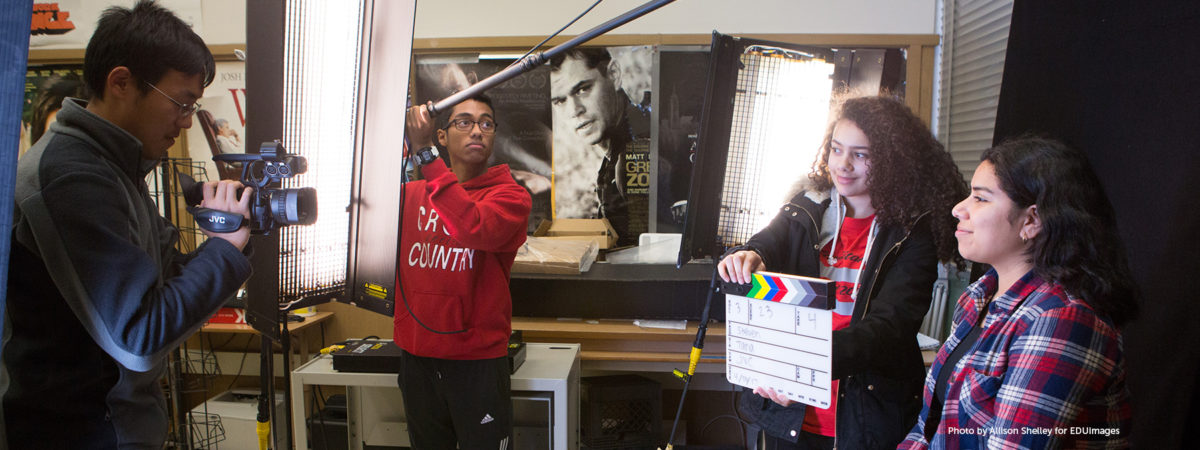
In a recent webinar hosted by Digital Promise titled “Building Systems that Support Connected Learning,” Dr. Mimi Ito, professor at UC Irvine, director of the Connected Learning Lab, and CEO of Connected Camps, shared her research on how opportunities for connected learning positively impact students. A diverse group of educators, school leaders, and curriculum developers attended and engaged in roundtable discussions where they considered the benefits and challenges related to implementing connected learning in schools. The presentation is available to view now.
This gap between students’ home and school experiences with interest-driven learning is an equity issue. Dr. Ito shared data illustrating that more affluent families have more than doubled their investments in interest-driven learning for their children, where less affluent families’ investment has remained relatively unchanged since the 1970s. School spending is compounding this trend, as schools serving less affluent populations are investing increasingly less in extracurriculars, an important touchpoint for interest-based connection for students.
Connected learning happens at the intersection of interests, relationships, and opportunities. Dr. Ito described connected learning as those experiences where young people are able to pursue something that they are genuinely invested in and passionate about with peers and caring adults who share that interest, whether in a physical community or in an online community, and that those interests and the related skills are tied to opportunities for academic development, career development, or civic engagement.

Caption: The elements of connected learning environments. Created by: Nat Soti
Alt text: A 3-part Venn diagram, with intersecting circles for interests, relationships, and opportunities. At the center intersection, elements of connected learning environments. In detail, sponsorship of youth interests, shared practices, shared purpose, and connections across settings.
Through the use of digital technologies, students have a greater opportunity to seek out a wide range of interests, find specialized information, and build community within affinity networks online; however, the lack of availability of these technologies outside of school has exacerbated the disconnect between home and the classroom. Oftentimes, the web of supports in the out-of-school space and in online communities follows a student throughout their education, whereas in formal education, relationships are often lost along the way in institutional transitions. Those relationships are often important social capital in the opportunities students may have access to in their future.
Dr. Ito acknowledged, “It’s not that all learning has to be connected learning all the time, but all young people deserve to have the experience of connected learning. We understand that kids need to be able to just pursue their interests just for fun, without it being school connected; they need to be able to mess around with their friends. And they need to be able to learn and do ‘school stuff’ that isn’t necessarily connected with their interests.”
Through research with students, Dr. Ito has found that interest-driven learning is often supported only in the home and community contexts. Intentionally supporting connected learning from school would make it more equitable. Dr. Ito presented a set of design principles that schools can use to connect learning from informal, out-of-school contexts to formal academic contexts: school sponsorship of youth interests, adults and students engaging in shared practices and purpose, and activities that foster connections across settings. She shared examples from schools ranging from eSports to action civics.
In breakout rooms, participants discussed how leaders and curriculum developers can support educators in creating connected learning. For example, Justice Ejik, Amanda Bratten, and others from the curriculum design team at Panopto attended the session to learn how they can build opportunities for connected learning into science curriculum.
This webinar was an extension of Digital Promise’s work sponsored by the Wallace Foundation on principal leadership in a virtual environment (2021). This webinar was the third in a series, with the goals of continuing the conversation and further advancing school leaders’ understanding of current, critical topics and their application in their learning environments.
Next, on Oct. 27 at 12 p.m. ET, we’ll host “Leveraging the Village for Real World Community Science Learning” with Dr. Tamara Clegg. Sign up for that webinar and the full series on Eventbrite.
Want to know more about supporting connected learning experiences? Below are resources recommended by Dr. Mimi Ito, as well as resources from Digital Promise:
Follow @DigitalPromise on Twitter to stay updated on upcoming research-to-practice webinars and events. Dr. Ito also invites you to follow her on Twitter at @mizuko.